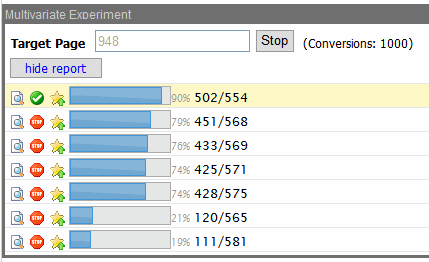Additional Information
Cookies in Multivariate Testing
When visitors view the experiment page, a cookie is set in the browser. This cookie indicates the specific variation seen by the visitor. From this point forward, if they next visit the target page, this cookie is read and the proper variation counter is increased.
A cookie persists forever or until the cookies are removed from the browser cache. The cookie gives a visitor a consistent page variation each time they revisit during the experiment.
Visitors that block cookies are not counted in conversions. Also, they see random page variations each time they visit the page.
Using a Target Page Outside of the CMS
When your target page is outside of your Web Site, you must create an intermediate page that contains the Target Widget, and redirect the visitor to the outside address.
For example, if you want to test visitors from your page to http://www.NFL.com, do the following:
1. Create a new Pagebuilder page.
2. Add the target widget to it.
3. Add the code that will redirect the visitor from this page to www.NFL.com.
4. Create content with links to the target page you just created.
Now when the experiment is running, the experiment page links the visitor to this intermediate page and the conversion is counted. Then, the redirect takes the visitor to the external page.
Repeating an Experiment
To repeat an experiment after it has ended, you first must restore the history of this page. To restore history of a PageBuilder page, follow the steps in Restoring a Previous Version.
After you restore the previous version, you may edit the parameters of the experiment, modify the content, and run the experiment again.
Scheduling an Experiment
The PageBuilder page has the same properties as other content types, including the Schedule Property. To set the beginning and ending date of the page, edit the PageBuilder page and follow the procedure for setting content schedules as described in Scheduling Content to Begin and End.
Be sure to set the Schedule End Date to be long enough past the time you believe the experiment will automatically end.
More Information About the Reports
Reports show how each variation has performed during the experiment. Click on the Show Report button in the Experiment Widget to see the progress and results.

The bar graph shows the conversion percentage.
The numbers to the right of the bar graph show two values. The first value is the percent of conversions compared to the total number of visits to the experiment page. On variation #2 above, the “79%” means that 568 visitors to this variation have successfully reached the target page 451 times.
The numbers after the percentage show the actual conversations. The first number before the “/” indicates the total number of conversions during the experiment. The second number is the total number of times this variation was viewed by a visitor.
Note: Users that are logged in are counted as a page view to the experiment page but not counted on the target page as a conversion.
The following table describes how to use each button.
|
Button |
Description |
|
|
Preview shows the page configurations for this specific variation. Notice that not only does the content in the Multivariate Section wizards change, but also the slider number changes too. |
|
|
Variation Enabled. When this shows, this variation is currently selected to run. Clicking on this button disables this variation. |
|
|
Variation Disabled. When this shows, this variation is currently not selected to run. Clicking on this button enables the variation. |
|
|
Promote. Clicking this button promotes this specific variation to become the actual page seen by visitors. All other variations are disabled and the experiment is ended. |
Using More Than One Section Widget on a Page
You may create a PageBuilder page with more than one Section Widget. This provides greater flexibility in helping to identify combinations of content and images that provide the best conversion results.
A page containing two Multivariate Section Widgets is shown below.

The contents inside the Section Widgets are part of the variations shown randomly during the experiment.
The Quantity of Variations Tested
The number of variations in a Multivariate Experiment grows exponentially as you add sections and variations.
For example, if you have two sections with 3 variations in each section, there are a total of 8 (23) pages to be tested. If you increase this to 4 variations each, there are 16 (24) pages.




